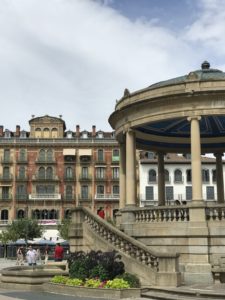Panoramic Pamplona
Guest Post by: Noah Reyna, a Junior studying Accounting and Finance at the Foster School of Business. Noah is currently participating in the Foster Exchange Program at the Universidad de Navarra.
Today is the 6th week mark of my arrival in Pamplona. It’s been quite an adaptation—I’ve never travelled outside of the US before (besides for Victoria, British Columbia), so everything from the transatlantic flight to the well-known Spanish siesta is new to me.
After my arrival in Pamplona, one of the first things that I noticed in local restaurants is the lack of vegetarian food—and, as a vegetarian in Seattle, there’s vast array of vegetarian and vegan restaurants for me to eat similar substitutes to traditionally meat-based dishes. But not here; as a result, I’ve frequently found myself cooking at home, which is not a bad thing necessarily. However, there is one notable Spanish tapa (which are called juevinxos in Pamplona) that I can eat—the Spanish tortilla. I can gladly say that it satisfies my needs for good vegetarian food, as they are cooked perfectly here in Pamplona. In terms of cost of living, let’s say that it’ll be much easier to fuel my caffeine dependency here. For a coffee that usually costs me around $5 in the greater Seattle area I can get for only €1.25, or about $1.4. For the restaurants that I have eaten at, the prices for some good Italian food (I know, I should be eating Paella…) are also reasonable.
Academics contrast greatly with those at Foster. While the classes are small, and the professor knows students by name, there aren’t a vast amount of homework assignments to grasp concepts learned in the classroom. Rather, there’s a smaller amount of homework assignments, but the work itself involves a greater amount of problem sets or lengthier readings. My Spanish class here actually only meets twice a week, similar to Foster classes, but the Spanish classes at UW meet 5 times a week. Thus, I am surprised that my Spanish-speaking abilities went from basic to conversational in such a short time; that is, if I’m speaking with the right person who’s speaking at the right pace.
The pace of life also differs with that of Seattle as well. For one, the siesta is real—all shops are closed from around 2:00 in the afternoon to 5:00 or 6:00 in the evening, with eateries opening around 8:00 for dinner. The sheer amount of food that the Spanish eat (I would say around 6 meals, including “la comida,” their ginormous lunch) is unbelievable to me. But I suppose it makes sense, considering that walking is more common than driving, with Pamplona being an extremely walkable city with lots of public transportation, such as the city bus, coach buses for travel to nearby cities, the train, and plane. The people here are extremely friendly. I enjoy my conversations with one of the owners at one of the nearby coffee shops, and times that I have been lost in Pamplona (or other parts of Spain) locals have always been willing to help with directions.
Finally, while Pamplona is a smaller city than Seattle, there are a considerable amount of activities to do, ranging from bars to have good conversations with other study abroad students to strolls in one of the many parks in Pamplona. During my first week here, I walked through around one park per day. The parks are large and have beautiful plants for some good photography shots.
Overall, for my first month and a half has already been an experience, and I am adapting to the culture and language well. I’m enjoying the small class sizes here, among the slower pace of life and cheap coffee!



